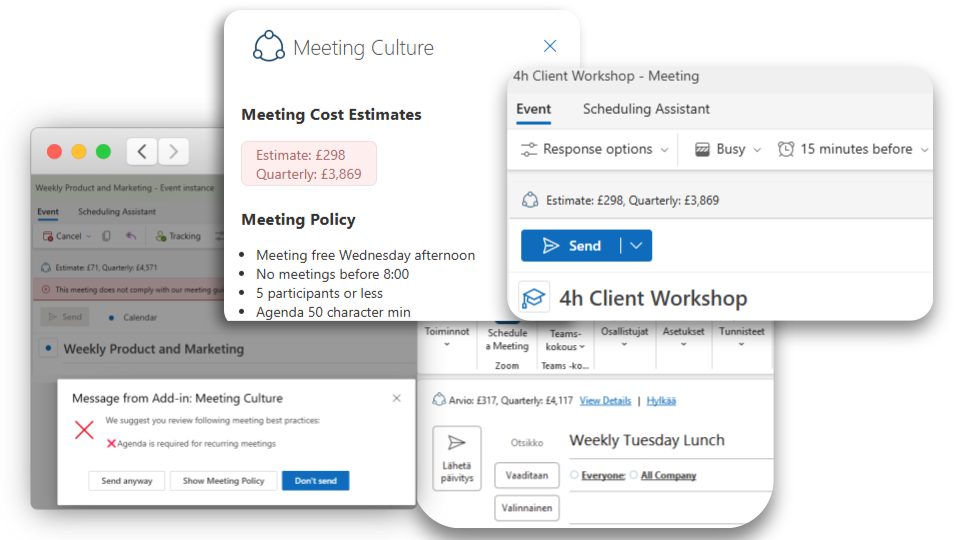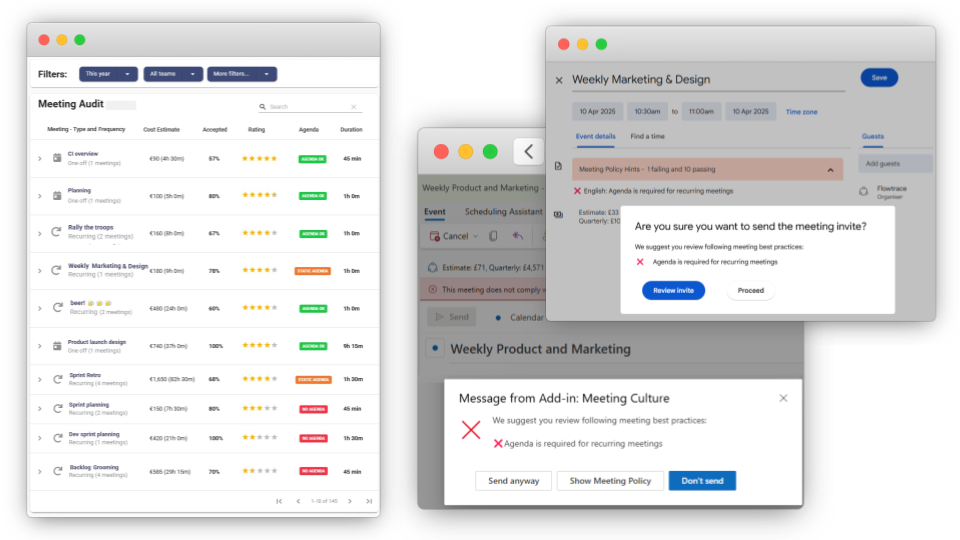How to Measure Wasted Meeting Time: A Data-Driven Approach
Learn how to identify and measure wasted meeting time to boost productivity with a data-driven approach. Discover actionable insights for better...
Learn how to quantify, reduce, and reclaim lost productivity from internal meetings, improving focus and decision-making in your organization.
Every organization talks about productivity, yet few examine the one metric that quietly destroys it, time spent in internal meetings. On paper, these sessions look harmless: one hour here, a weekly update there. But when multiplied across teams and salaries, they represent one of the largest hidden costs in modern work.
The rise of hybrid collaboration has made this even more visible. Calendars are crowded, focus time is shrinking, and meeting fatigue is becoming a cultural norm. Leaders are starting to ask sharper questions:
This article explores how to quantify the real cost of internal meetings, not just in budget terms, but in lost focus, decision-making speed, and innovation capacity. You’ll learn how to calculate meeting cost, identify waste, and introduce analytics to help your teams reclaim time for meaningful work.
Most organizations underestimate how expensive internal meetings have become. Every recurring update, project sync, and ‘quick catch-up’ consumes paid time and attention, often without delivering measurable value.

According to one report, the average professional now spends nearly 57% of their week in meetings and emails, leaving less than half their time for focused work. Multiply that across departments, and meetings quietly become one of the largest operational costs in modern work.
The challenge isn’t that meetings exist. It’s that few organizations measure their true cost in salary, in lost focus time, and in delayed decision-making. That’s where the conversation about meeting culture must begin.
Understanding the true cost of internal meetings isn’t about eliminating collaboration, it’s about recognizing how time converts directly into organizational performance. Every hour spent in a meeting has both a financial and cognitive price tag.
From a financial perspective, internal meetings are among the largest untracked expenditures in any company. Data from Flowtrace shows that the average employee spends 21 hours per week in meetings, and that unproductive sessions cost companies billions annually. At scale, a single recurring meeting can represent tens of thousands in annual salary cost, often with unclear outcomes.
But the cost runs deeper than budget lines.
Every meeting also consumes deep work capacity, the uninterrupted time required for strategic thinking, innovation, and meaningful execution. When calendars fill with overlapping syncs, teams experience:
The organizational impact extends further.
Excessive internal meetings impact across departments, delaying delivery timelines, inflating project overhead, and quietly forming a culture where time feels expendable. Leaders lose visibility of where collective hours go, and employees feel the pressure of being constantly ‘in meetings’ without moving work forward.
Recognizing this isn’t about austerity; it’s about alignment. By quantifying and managing meeting costs, organizations can reclaim time for what drives real value: decisions, creativity, and focus. This is the foundation for any meaningful productivity or transformation initiative.
Internal meetings expand for understandable reasons: new initiatives, stakeholder alignment, leadership check-ins. But over time, unreviewed recurring invites accumulate, creating calendar debt.

Three structural drivers are common:
When these factors combine, the organization begins trading deep work for meeting volume. Studies from Harvard Business Review suggest that over 70% of meetings prevent employees from completing their own work efficiently.
The productivity impact accumulates: each meeting hour multiplies by the number of attendees, and every interruption fragments cognitive focus. A single one-hour meeting with 10 participants equals 10 collective work hours, plus recovery time before meaningful work resumes.
To manage meeting time strategically, you must first make it visible in financial terms.
.png?width=1366&height=768&name=Outlook%20Add%20In%20Store%20Images%20-%201%20(1).png)
The basic formula is simple:
Meeting Cost = Attendees × Average Hourly Cost × Duration × Frequency
Consider a recurring 30-minute team update:
The annual cost is: 8 × £60 × 0.5 hr × 52 weeks = £12,480 per year
Now multiply that by dozens of similar meetings across functions, and the number escalates quickly. According to research from Forbes, large enterprises spend millions each year on recurring internal meetings, much of it on sessions that could be shortened, restructured, or replaced with asynchronous updates.
These are not abstract losses; they represent concrete opportunity costs, time and payroll allocated without direct correlation to outcomes.
Financial cost is only part of the picture. The true burden lies in what those hours replace: strategic thinking, creative problem-solving, or deep execution work.
Research from Atlassian found that 31% of employees consider most meetings unnecessary, while 65% say meetings interrupt their ability to do focused work. When calendar fragmentation increases, cognitive fatigue follows.
Opportunity cost shows up in three forms:
In transformation terms, excessive internal meetings impact organizational agility. The hours appear in payroll but disappear in output.
Reforming meeting culture requires structure, not just good intent. Start with data, then redesign deliberately.

Extract calendar data for your organization or team. Quantify total meeting hours per week, by function and role. Identify top recurring meetings by duration and participant count.
Tag each meeting:
Patterns will emerge. Update meetings tend to dominate, yet produce the lowest value per hour.
.png?width=960&height=540&name=Marketing%20Images%20(8).png)
Apply the cost formula for the most time-intensive meetings. Add a productivity viewpoint: how many hours of focused work could these sessions be displacing?
Track outcomes over several months. Reduced meeting volume should correlate with improved focus time, faster decision cycles, and higher engagement scores.
When this process is repeated, teams typically recover 10–15% of their working hours within one quarter, equivalent to an additional workday every two weeks.
Manual audits are valuable, but sustained visibility requires automation. That’s where meeting analytics and Flowtrace Cost Calculator can help leaders turn qualitative change into quantitative insight.
Flowtrace automatically:
By connecting meeting data to performance and focus metrics, you can manage time as a resource, not just a calendar entry.
Reducing meeting costs is not simply about efficiency; it’s about reclaiming strategic time. As hybrid and distributed work evolves, leaders need to design communication systems that preserve alignment without consuming every available hour.
The future of high-performing organizations will depend on this balance:
Time is the most expensive asset every organization owns, but also the least measured. Start with visibility. Quantify the real cost of internal meetings, then redesign how your teams collaborate to protect the hours that matter most.
Measuring meeting costs helps leaders understand how much time and salary are being spent on recurring discussions that may not deliver value. Without visibility, these hours accumulate into hidden operational costs that reduce focus, decision speed, and innovation capacity. Quantifying this time allows organizations to make data-driven decisions about how to collaborate more efficiently.
The cost depends on team size, salary levels, and meeting frequency. For example, a 60-minute weekly meeting with ten employees earning $60 per hour equals roughly $31,000 annually. When multiplied across dozens of recurring meetings, the total can reach hundreds of thousands or even millions per year for mid-sized organizations.
Hidden costs go beyond direct payroll. They include lost deep-work time, context switching, meeting fatigue, and the opportunity cost of delayed decisions. These factors compound across teams, reducing productivity and engagement even when meetings seem well-intentioned.
Use this simple formula:
Cost = Attendees × Average Hourly Cost × Duration × Frequency.
Start with your highest-frequency or largest recurring meetings. Estimating these figures can quickly reveal where time and money are being lost — and where small adjustments deliver the biggest return.
Begin by auditing recurring meetings across your organization.
This structured approach typically frees up 10–15% of total work hours within a few months.
Learn how to identify and measure wasted meeting time to boost productivity with a data-driven approach. Discover actionable insights for better...
Learn how to identify, understand, and reduce hidden meeting overhead costs to improve financial efficiency, boost productivity, and enhance employee...
Discover the best meeting-efficiency software to optimize productivity, reduce meeting overload, and enhance deep-work time with data-driven insights...